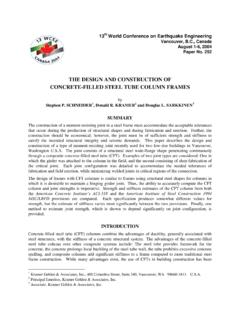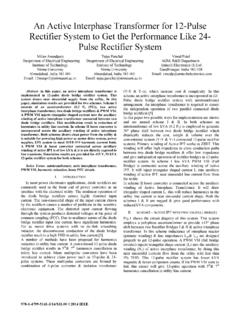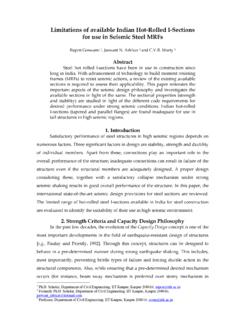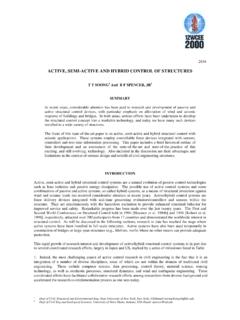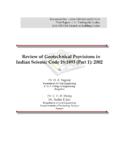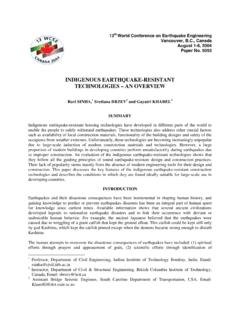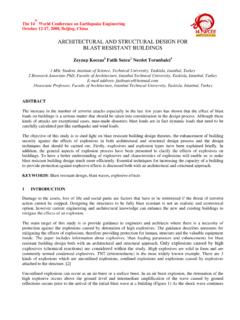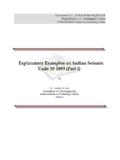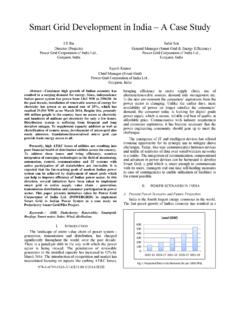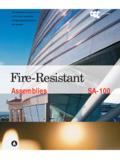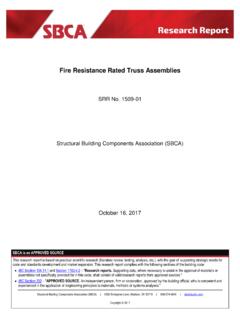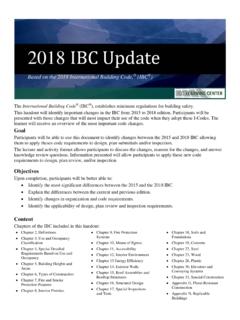Transcription of Commentary on National Building Code (Part 4) – Fire and ...
1 Document No. :: Final Report :: C - fire Codes IITK-GSDMA Project on Building Codes Commentary on National Building code (Part 4) fire and Life Safety by fire Adviser, Govt. of India {Retd.} Cochin Ex-Chairman CED-22 fire Fighting Sectional Committee Bureau of Indian Standards. Manager{Retd},TAC/GIC,Ahmedabad Ex-Chairman CED-36 fire Safety Sectional Committee Bureau of Indian Standards. This document has been developed under the project on Building Codes sponsored by Gujarat State Disaster Management Authority, Gandhinagar at Indian Institute of Technology Kanpur.
2 The views and opinions expressed are those of the authors and not necessarily of the GSDMA, the World Bank, IIT Kanpur, or the Bureau of Indian Standards. The Commentary is based on the Final Document of Part 4 fire and Life Safety, which is under print. Suggestions of the authors for certain modifications in the code have been forwarded to BIS separately Comments and feedbacks may please be forwarded to: Prof. Sudhir K Jain, Dept. of Civil Engineering, IIT Kanpur, Kanpur 208016, email: & SCOPE4 - - PREVENTION16 - SAFETY45 - PROTECTION67 - REQUIREMENTS79 - 1 to 18110 - 20 to 22125 - 23127 - 24136 - A &TABLES 25 & 26 - Calorific Values of common Materialsand Typical Values of fire Load Density138 - B - Broad Classifications of Industrial &Non-Induatrial Occupancies intodifferent degree of Hazard141 - C - fire Protection Requirements forHigh Rise Buildings145 - D - fire Protection Considerations forVenting in Industrial Buildings161 - E - Guidelines for fire Drill and EvacuationProcedures for High Rise
3 Buildings173 - F - List of Standards188 - G - List of H - Govt. of India, Min. of UD & PA(Delhi Division) Notification dated 28th Aug. 2002198-200 Commentary on National Building code (Part 4)Page 3 IITK-GSDMA-Fire03 - Building code OF INDIAPART 4 fire AND LIFE SAFETY-2005(Second Revision of SP 7-Part 4)CODECOMMENTARYFOREWORDA broad overview of the contents of the Foreword (asshown on the left), is outlined below:(i)Part-4 of NBC deals with the requirementsnecessary to minimise danger to life and propertyfrom fire and adopts an integrated approach.(ii) fire Protection techniques should be based on firecharacteristics of Building materials and elements ofstructure, and requirements of the code should beadopted in toto for ensuring a fire safe design andconstruction of buildings.
4 (iii)For this, qualified and trained fire experts have to beclosely associated with the Building industry, rightfrom the planning and design stage of the Building .(This aspect has been strongly advocated by theStanding fire Advisory Council, Govt. of India also,which is the highest policy making body for the FireProtection Services in the country.(iv)While the code prescribes only the minimumstandards of fire protection and fire safety ofbuildings, both in the interests of the occupants ofthe buildings and also in the public interests, nothingin the Part prohibits adoption of higher , it will be necessary for all concerned to complywith all requirements of fire safety as prescribed infire-related legislative provisions.)
5 (v)Detailed coverage has been provided about the HalonPhase-Out policy guidelines as well as thedevelopment and adoption of the Standards on HalonAlternatives. In fact, this subject has been dealt within detail under Commentary Section Asmentioned therein, 12 new Indian Standards onHalon Alternatives are already under publication, asascertained from the BIS, and 19 existing IndianStandards, where there are references on Halon, areunder revision/upgradation.(vi)The final revised version of Part-4 NBC is under printand expected to come out soon by June 2005(according to BIS sources)
6 The material projectedin the code part of this document is a reproductionof the final revised version of NBC Part 4, which wassent for printing, as obtained from the part of the code deals with safety from specifies the demarcation of fire zones, restrictionson construction of buildings in each fire zone,classification of buildings based on occupancy, typesof Building construction according to fire resistance ofthe structural and non-structural components and otherrestrictions and requirements necessary to minimisedanger to life from fire , smoke, fumes or panic beforethe buildings can be evacuated.
7 The code recognizesthat safety of life is more than a matter of means ofexits and accordingly deals with various matters whichare considered essential to the safety of protection techniques have to be based on thefire behavior characteristics of different materials andstructural elements of buildings. The activities pursuedby the occupants of buildings must also be taken intoconsideration for assessing the extent of hazards, andmethod should then be devised by which the hazardscould be minimised. An indefinite combination ofvariables is involved in the phenomenon of fire , all ofwhich cannot be quantified.
8 The requirements of thisCode should, therefore, be taken as a guide and anengineering design approach should be adopted forensuring a fire safe design for buildings. It would alsobe necessary for this purpose to associate qualifiedand trained fire protection engineers with the planningof buildings, so that adequate fire protection measurescould be incorporated in the Building design right fromthe safety from fire is not attainable in objective of this part is to specify measures thatwill provide that degree of safety from fire which canbe reasonably achieved. The code endeavours to avoidrequirements that might involve unreasonablehardships or unnecessary inconvenience or interfer-ence with normal use and occupancy of buildings, butinsists upon compliance with minimum standards forfire safety necessary in public interest.
9 For ensuringcompliance of fire protection equipments/installationsto the laid down quality requirements, it is desirable touse such equipments/installation duly certified underthe BIS Certification Marks providing guidelines for minimising chances ofoccurrence of fire through passive fire protectionPage 4 IITK-GSDMA-Fire03 - on National Building code (Part 4)CODECOMMENTARYPage 5 IITK-GSDMA-Fire03 - on National Building code (Part 4)measures, this part does not intend to cover allaspects of general fire prevention including sources ofignition. Nor does it cover the prevention of accidentalpersonal injuries during the course of normal occupancyof part while recognising that panic in a Building onfire may be uncontrollable, deals with the potential panichazard through measures designed to prevent thedevelopment of panic.
10 Experience indicates that panicseldom develops even in the presence of potentialdanger, so long as occupants of buildings are movingtowards exits which they can see within a reasonabledistance and with no obstruction or undue congestionin the path of travel. However, any uncertainty as tolocation or adequacy of means of egress, thepresence of smoke or fumes and the stoppage of traveltowards the exit, such as may occur when one personstumbles and falls on stairs, may be conducive to from panic is greater when a large number ofpeople are trapped in a confined has shown that concealed spaces within abuilding such as space between ceiling and falseceiling, horizontal and vertical ducts, etc, tend to actas flues/tunnels during a fire .

